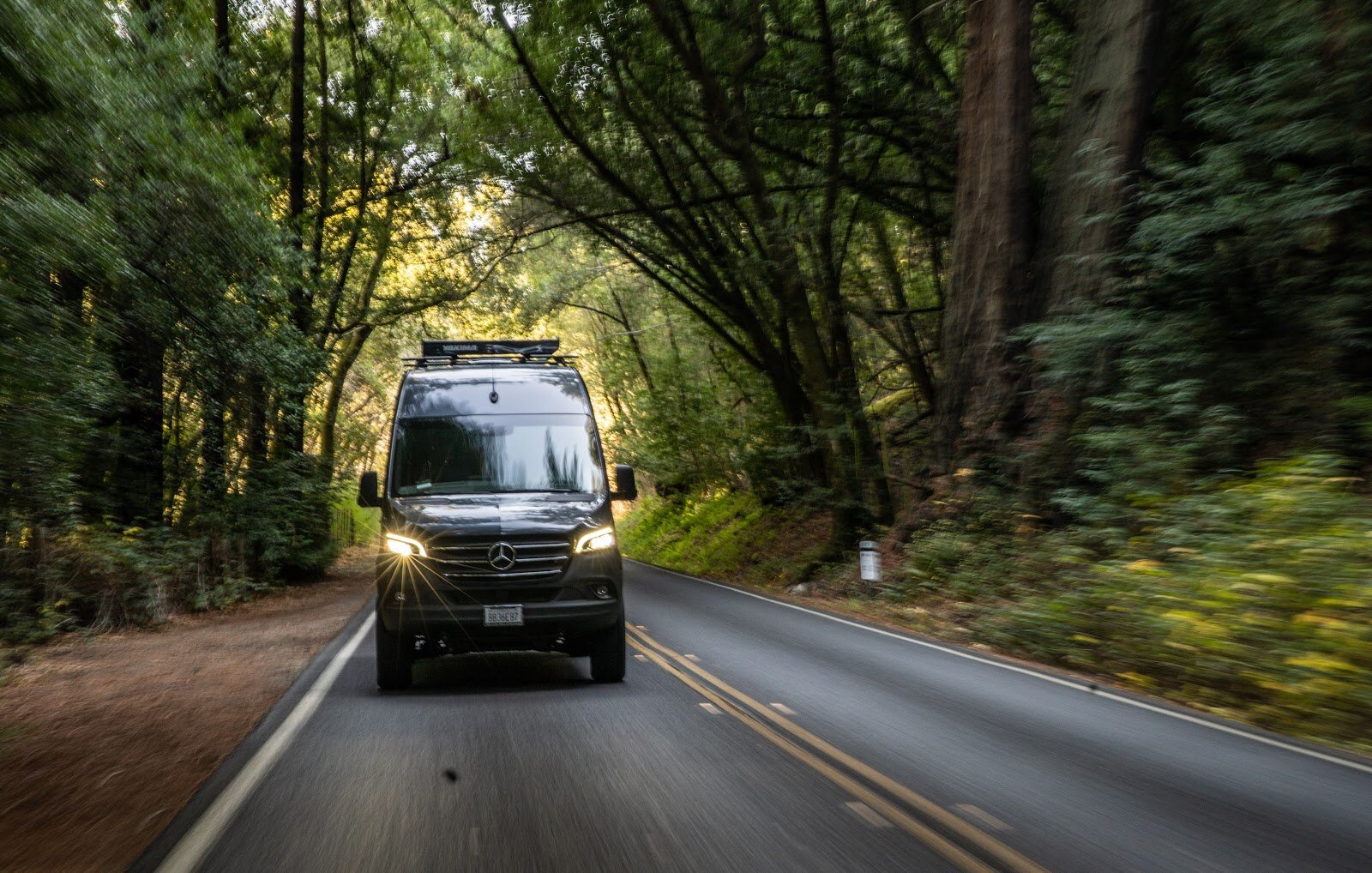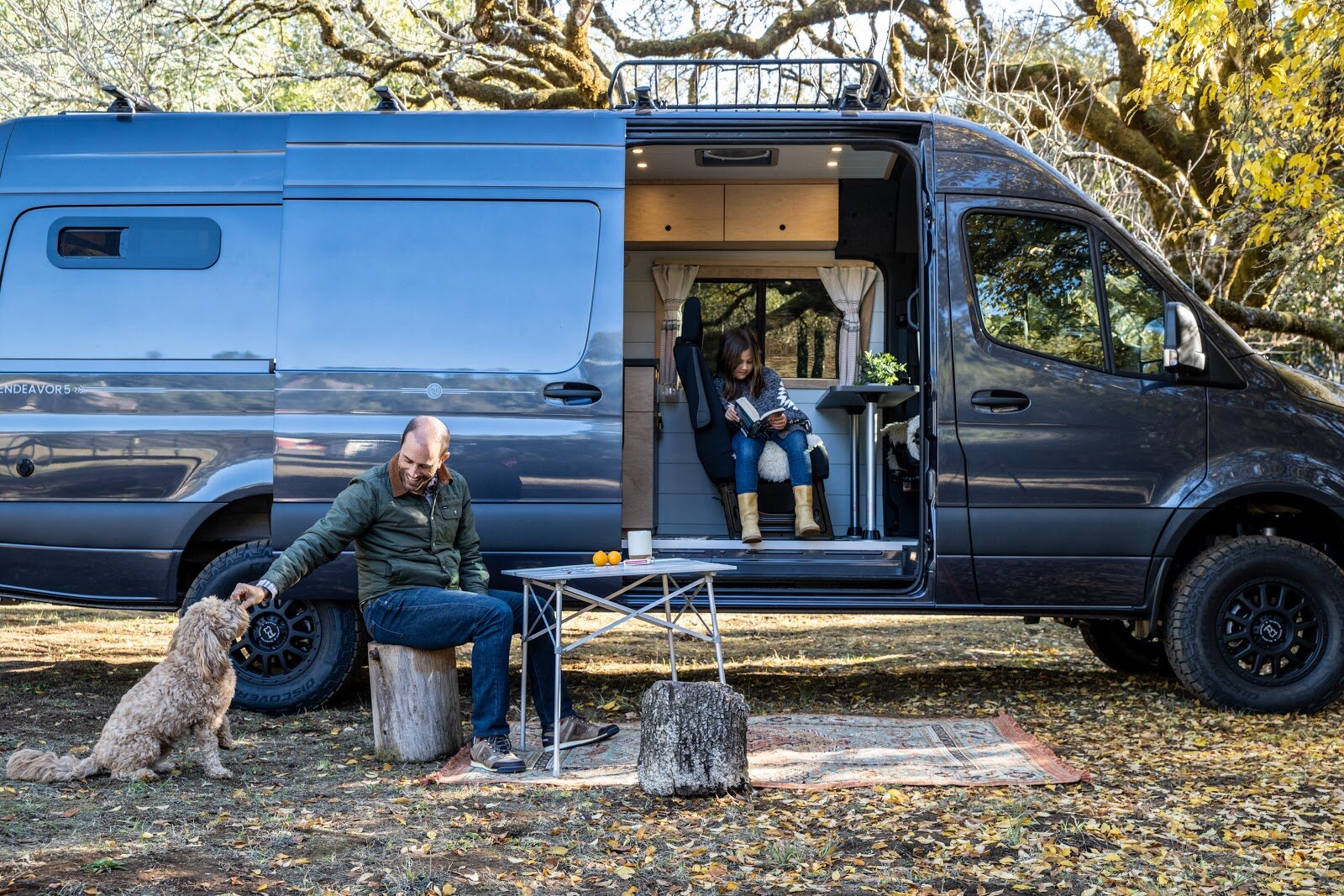What is the Best Battery for a Campervan? AGM vs. Lithium
What is the Best Battery for a Campervan? AGM vs. Lithium
Photo by Muse & Co. Outdoors
Your leisure battery bank needs to be up to the task of supplying consistent and reliable power in the demanding environment of your camper van. There are many options available for deep cycle, maintenance-free batteries, but among them, Absorbed Glass Mat (AGM) and lithium iron phosphate batteries (LiFePO4) are by far the most popular in camper van applications.
With recent technology improvements, lithium batteries have emerged as the clear frontrunner for campervans and motorhomes and are widely known as the best RV batteries. Lithium is the best type of battery for campervans because they are more efficient, have the longest lifespan, are safe to operate, are compact and light, and are cost-effective in the long run.
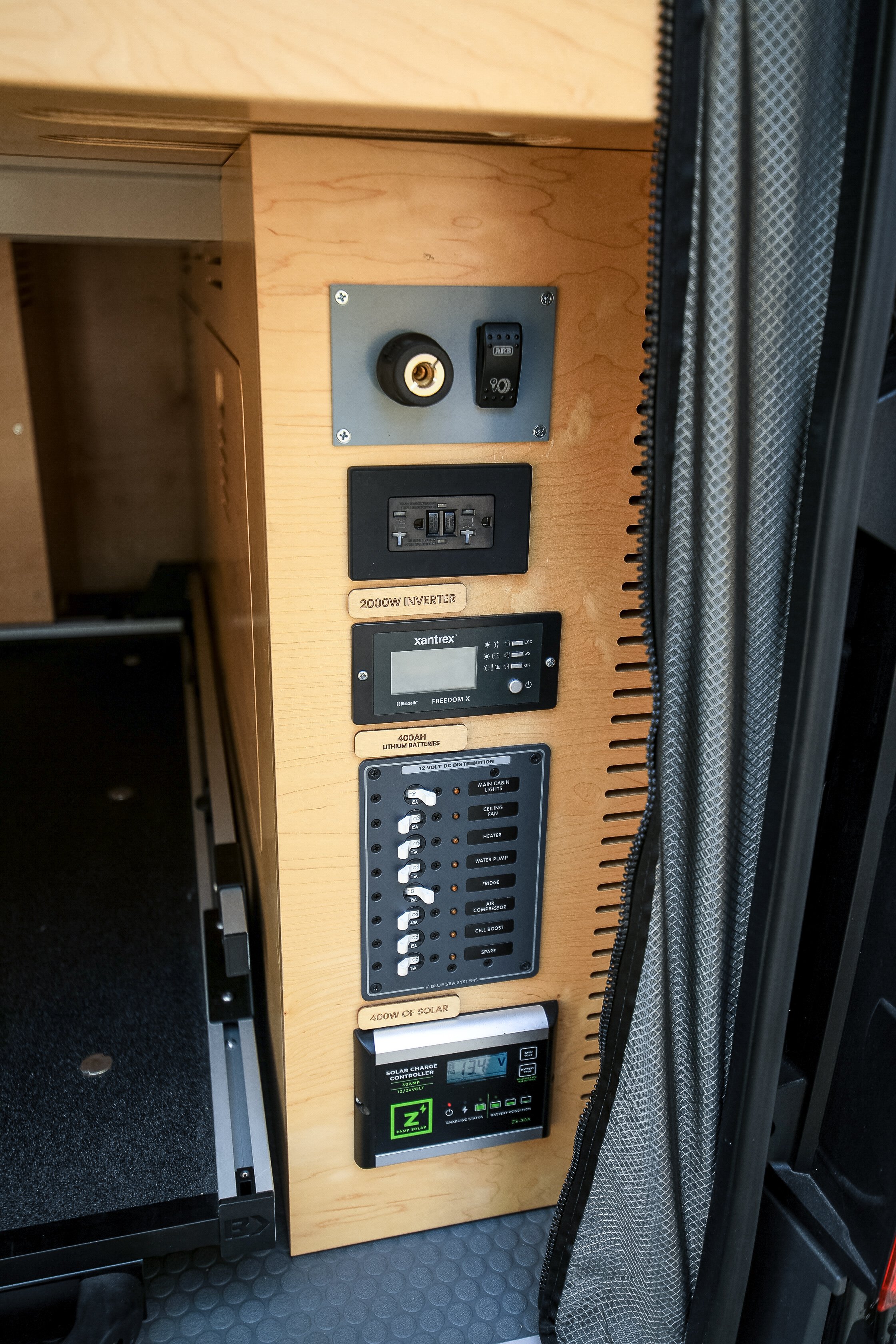
Photo by Muse & Co. Outdoors
Efficiency
Lithium batteries are much more efficient than lead-acid batteries (the family of batteries to which AGM belong). Efficiency in batteries refers to the amount of energy lost during the charging process.
Lithium batteries are around 95% efficient, while lead-acid batteries are 80-85% efficient. This means that for every 100 watts of charging energy that goes into the batteries through a solar charger, lithium batteries retain about 10-15% more of that energy and make it available for use by appliances or an inverter.
In van life applications, this disparity in efficiency is a big deal. Solar panels are mounted on the roof of the van, where there is limited space. It is critical that the maximum possible amount of solar energy that is absorbed by the panels and sent to the batteries with a solar charge controller ends up being converted into usable power for your van.
Because of their superior efficiency, lithium batteries charge faster than AGM batteries. This is an important advantage when you are camping off-grid without shore power and solar power is limited.
Lifespan
Lifespan might be the biggest strong point of lithium batteries. Battery lifespan is measured in charge cycles, or the number of times a battery can be discharged and recharged. While AGM batteries can handle up to 400 to 1000 cycles, depending on battery quality and depth of discharge (DOD), lithium batteries can manage around 5,000 to 10,000 cycles.
The translation? Cycling your lithium batteries once per day (which you would only do if you were living full-time in your Sprinter van) would yield a lifetime of around 14 years. AGM batteries cycling once a day, on the other hand, might only last 1-3 years. Most lithium-ion batteries come with a 5 to 10-year warranty, while AGM batteries come with much shorter warranties.
Safety
12-volt lithium batteries are the safest choice for use in a camper van. Although sealed lead-acid batteries like AGMs are safer than traditional lead-acid batteries, they still present some safety concerns that should be considered for a camper van installation.
Both AGM and lithium batteries include technology to prevent overcharging. AGM batteries require ventilation to prevent the build-up of hydrogen gas. If this gas is allowed to accumulate, it can poison the air, cause battery damage, and, in extreme cases, lead to an explosion.
While issues with battery safety are relatively uncommon even with AGM batteries, there is no question that lithium is the safer choice. To protect your van and everyone inside it, lithium batteries are the way to go.
Weight and Size
Weight is an important factor in any camper van conversion. Heavier builds put more stress on the van and lead to losses in performance and gas mileage. Suspension components, tires, and brakes may need to be replaced more frequently in vans that carry more weight.
Simply put, any opportunity to cut weight in a van build should be capitalized on. AGM batteries are very heavy when compared to lithium. In fact, when comparing two 12v 100ah batteries, the AGM option will be about three times heavier.
LiFePO4 batteries are also generally smaller than AGM deep cycle batteries that offer the same amount of usable energy, meaning you can save precious space and make your Sprinter van electrical system compact and discreet.
Depth of Discharge
To understand how to compare the weight and size of different battery options, it is important to understand the differences among them in terms of their depth of discharge. 12V deep cycle batteries are sized in amp-hours(AH), and common sizes for 12V batteries include 100AH, 150AH, and 200AH.
A 100AH lithium battery and a 100AH AGM battery do not have the same amount of usable energy, and that is largely due to depth of discharge. In order to avoid long-term battery damage, AGM batteries can only be discharged to 50% of their capacity. In other words, a 100AH AGM RV battery only has 50AH of usable energy. Lithium batteries, on the other hand, can be discharged 80-100% without causing damage to the battery.
Thus, a 100AH lithium battery has up to twice the actual battery capacity of its 100AH AGM counterpart. This is one of the main reasons why lithium batteries are lighter and smaller. It also makes lithium batteries simpler to use, because you don’t need to constantly monitor them with a battery management system (BMS) and worry about discharging them too much.
Operating Environment
Lithium batteries have some challenges when it comes to cold temperatures. Specifically, lithium batteries cannot be charged when their temperature is below freezing. AGM batteries do not have this issue, although they will take a small hit to their efficiency when charging in cold temperatures.
While many camper vans have heaters in the cabin that can keep the batteries at a chargeable temperature, there are some situations where this will not be enough. If you go on ski trips or camp in cold climates frequently, you will need a solution that makes it possible to charge your campervan batteries in cold temperatures, even when you are away from your van and the heater is off.
Fortunately, lithium battery technology continues to improve and now there are high-quality batteries that can completely work around this issue.Muse & Co. Outdoors vans include four100AH Battle Born batteries that include a built-in heating system. These state-of-the-art batteries include a self-heating function that keeps them at a safe temperature for charging, even in cold conditions! The self-heating function completely negates the only major downside of lithium batteries.
Cost
When it comes to the cost breakdown of lithium vs. AGM batteries, the old adage is true: “You get what you pay for.” Lithium batteries are more expensive upfront than AGM batteries with the same capacity. But while a 100AH lithium battery might cost twice as much as a 200AH AGM battery, you still get far more value out of the lithium.
As discussed above, the battery life of lithium batteries is around 10 times longer than AGM. The math is simple: A battery that costs twice as much, but lasts 10 times as long, is actually five times cheaper. That’s not to mention all the other advantages of lithium, including smaller battery size and weight, higher efficiency, and greater safety.
To learn more about Muse & Co. Outdoors vans and all the top-of-the-line components included in our builds, check outour models.
VIDEO: Hey, Noah! Why Do We Use Maritime Hardware In Our Builds?
As part of our ongoing “Hey, Noah!” video series, today Noah tells you why we opt to use maritime hardware in all of our van builds, and why we feel maritime hardware is superior to any other hardware option on the market.
Make sure to check out the other videos in the “Hey, Noah! | Your Van Conversion Questions Answered” series to learn more about our sustainable, luxury Sprinter van builds.
For more information on Muse & Co Outdoors, check out our website at https://www.museoutdoors.com/
Follow us on Instagram at https://www.instagram.com/muse_outdoors/
VIDEO: Hey, Noah! When Do I Need a 4wd Van?
As part of our ongoing “Hey, Noah!” video series, today Noah talks about the difference between buying a 4wd versus a 2wd drive van, and when you would really, truly need a 4wd capable van versus a 2wd.
Make sure to check out the other videos in the “Hey, Noah! | Your Van Conversion Questions Answered” series to learn more about our sustainable, luxury Sprinter van builds.
For more information on Muse & Co Outdoors, check out our website at https://www.museoutdoors.com/
Follow us on Instagram at https://www.instagram.com/muse_outdoors/
VIDEO: Hey, Noah! What’s That Silver Thing on the Side of the Van?
As part of our ongoing “Hey, Noah!” video series, today we answer a common question about what the heck that silver thing is on the side of our vans! That small silver thing is actually a vital part of ensuring our water tanks don’t burst. Watch the video to find out exactly why …
Make sure to check out the other videos in the “Hey, Noah! | Your Van Conversion Questions Answered” series to learn more about our sustainable, luxury Sprinter van builds.
For more information on Muse & Co Outdoors, make sure to check out our website at https://www.museoutdoors.com/
Follow us on Instagram at https://www.instagram.com/muse_outdoors/
VIDEO: Hey, Noah! Why Do We Use Shiplap Siding in Our Van Builds?
As part of our ongoing “Hey, Noah!” video series, today Noah explains why we feel it’s important to use shiplap wood siding in our van builds.
Make sure to check out the other videos in the “Hey, Noah! | Your Van Conversion Questions Answered” series to learn more about our sustainable, luxury Sprinter van builds.
For more information on Muse & Co Outdoors, make sure to check out our website at https://www.museoutdoors.com/
Follow us on Instagram at https://www.instagram.com/muse_outdoors/
VIDEO: Hey, Noah! Do We Have Any Vans For Sale Right Now?
As part of our ongoing “Hey, Noah!” video series, today we tell you all about our vans we currently have for sale and ready to go! Your #vanlife is closer than it may seem …
Make sure to check out the other videos in the “Hey, Noah! | Your Van Conversion Questions Answered” series to learn more about our sustainable, luxury Sprinter van builds.
For more information on Muse & Co Outdoors, make sure to check out our website at https://www.museoutdoors.com/ Follow us on Instagram at https://www.instagram.com/muse_outdoors/
VIDEO: Hey, Noah! What Makes Our Van Builds The Most Sustainable In The Industry?
As part of our ongoing “Hey, Noah!” video series, today we discuss what makes our van builds the most sustainable in the industry. We are proud to prioritize sustainability and environmentally friendly materials in our van builds. Everything from the wood finishes to the insulation is thoughtfully chosen with the environment – and your health – in mind.
Make sure to check out the other videos in the “Hey, Noah! | Your Van Conversion Questions Answered” series to learn more about our sustainable, luxury Sprinter van builds.
For more information on Muse & Co Outdoors, make sure to check out our website at https://www.museoutdoors.com/
Follow us on Instagram at https://www.instagram.com/muse_outdoors/
Why a Fully Custom Sprinter Van Conversion Might Not be the Best Option for You
The #vanlife is appealing for so many reasons. Owning a camper van makes traveling to your favorite places simple and easy. A well-designed camper van allows you to be comfortable wherever you go.
Nowadays, people looking for camper vans have many options. There are companies across the country that specialize in converting Sprinter vans. Part of this growing trend is the custom van niche.
Fully custom Mercedes-Benz Sprinter van conversions might seem appealing at first—you get to work with a professional builder to design the exact camper van layout that you want. What’s not to like?
In reality, there are several commonly overlooked reasons why a fully custom Sprinter camper van conversion might not be a great choice for you. In this article, we will go over some of the downfalls of fully custom conversions, and tell you how to get the van of your dreams while avoiding these headaches.
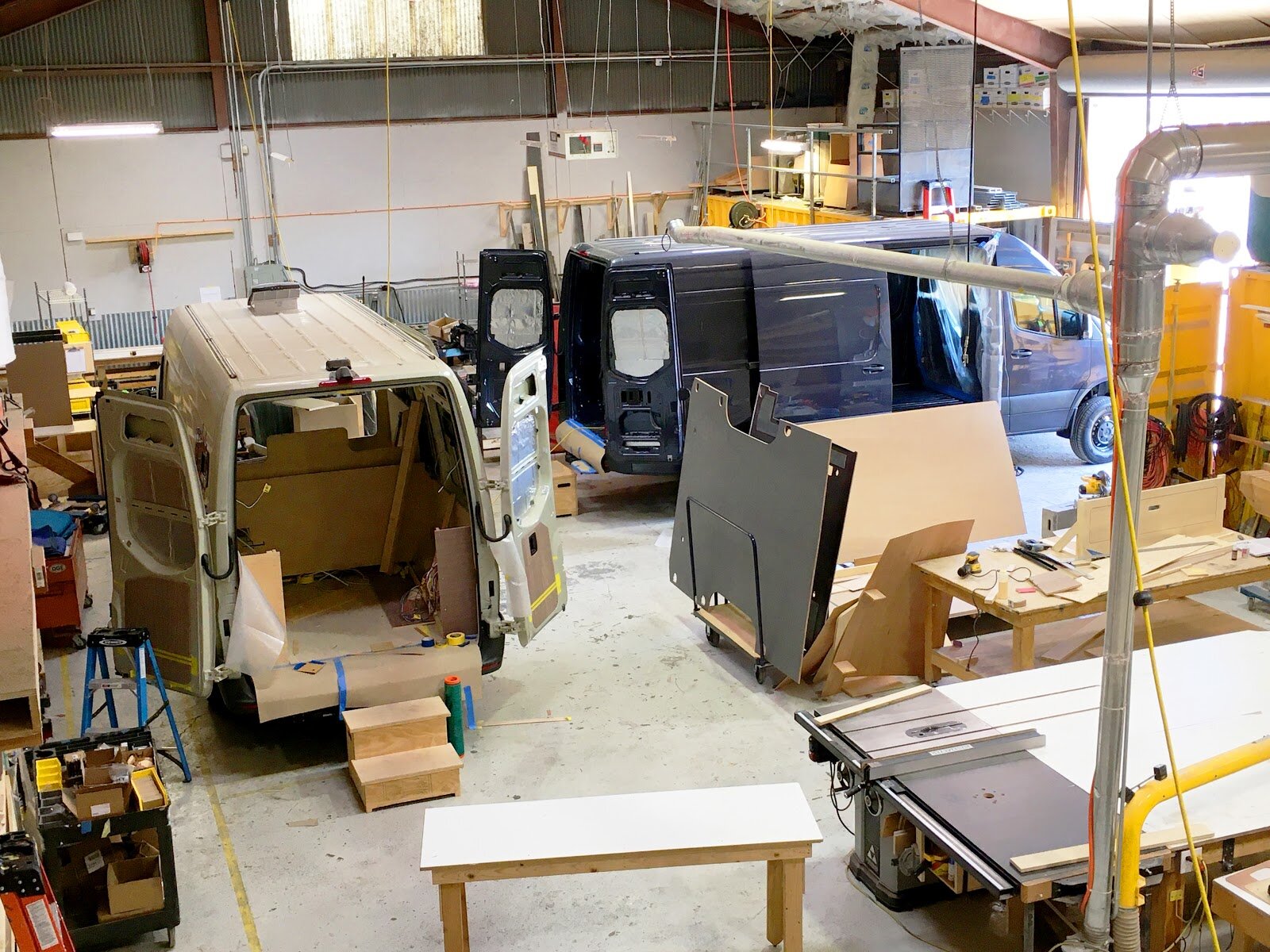
Time & Effort
So, you’ve decided that you want a Sprinter camper van. Chances are if you’re reading this article, you’ve already decided on having the work done professionally. Good choice! Many DIY-ers get in over their heads on van builds, and professional conversion companies are a great option for those who just don’t have the time or expertise to tackle this project.
As you shop around for a van conversion company, you’ll find that many van builders offer fully custom conversions—they will work with you to design a layout and choose accessories and equipment that you like. This might sound tempting at first, but the truth is that hiring a company to do a fully custom conversion defeats much of the purpose of outsourcing the work.
Fully custom van builds require you to be super involved in the process, from start to finish. You’ll need to work with designers to make decisions on minute details, such as what type of flooring you want, exactly how much battery power you need, and more.
As anyone who has been through this process can tell you, the decisions that must be made when designing a custom van are virtually endless. Many of them also require in-depth research. What seemed like a fun process can turn into a huge, time-consuming headache.
Finally, wait times for fully custom builds tend to be much higher than those for replicated models. Demand for Sprinter conversions is at a record high, and you could be waiting a year or longer to hit the road in your custom van.
Cost
If you’re doing so much of the decision-making for the camper van design yourself, you might think that effort would translate into a lower cost for your conversion. Unfortunately, the opposite is true—custom camper vans tend to cost a lot more than other options.
From a camper van conversion company’s perspective, a custom van conversion is more time-consuming and difficult. Not only do they have to consult with their client on every aspect of the build, but they also have to design and build a completely unique floor plan.
Many camper van conversion companies have streamlined ways of building many parts of their replicated layouts. They use the same vans with the same wheelbase, and have many of the parts, such as the kitchen cabinetry, already fabricated. With a custom build, every aspect must be uniquely fabricated, making production times and costs substantially higher.
If you are set on a fully custom build, you should be prepared to pay your chosen van upfitter top dollar for it.

Design Expertise
A great benefit of some of the best Sprinter van conversion companies is their design expertise. When you purchase a professionally-built Sprinter camper van from one of the top builders, every detail has been thought through and you can feel the builder’s expertise as you use the van.
Hiring a company to do a fully custom conversion could have the unintended effect of preventing that builder’s design prowess to shine through. While you may have some great ideas for the upgrades and options you want to include in your van, it can be difficult for builders to actualize their full potential when they have to consult with their clients to make design decisions.
In addition to design decisions, there are endless gear and material-related decisions to make when building a van. Camper van conversion companies have often already done the research and tried several products before choosing components for their vans. You could end up with inferior products if you are deciding on every component, from which awning to include to what wi-fi extender you want on the roof.
Unless you’re willing to commit to a very lengthy and expensive process, it may be a better idea to purchase a pre-designed model from a camper van conversion company whose designs you feel drawn to.
What’s the Alternative?
If we’ve talked you out of a fully custom camper van conversion, you may be wondering how you can still get a van that feels like your own while avoiding the drawbacks explained above.
Some companies, such as Muse & Co. Outdoors, offer pre-designed layouts that leave room for options and customizations. This is truly the best of both worlds – you reap the benefits of Muse & Co.’s decades of combined design and build experience, and you still get the chance to make your Sprinter camper van your own.
Muse Outdoors is a Bay Area custom camper van builder. We offer two models: the Endeavor 5, with seating for the whole family, and the Venture 2, the perfect getaway vehicle for couples or solo travelers. Once you’ve chosen a model, you can select from options and accessories packages to fit your lifestyle on the road. Finally, you get to make your van feel like home by picking one of Muse Outdoors’ professionally curated color and material palettes.
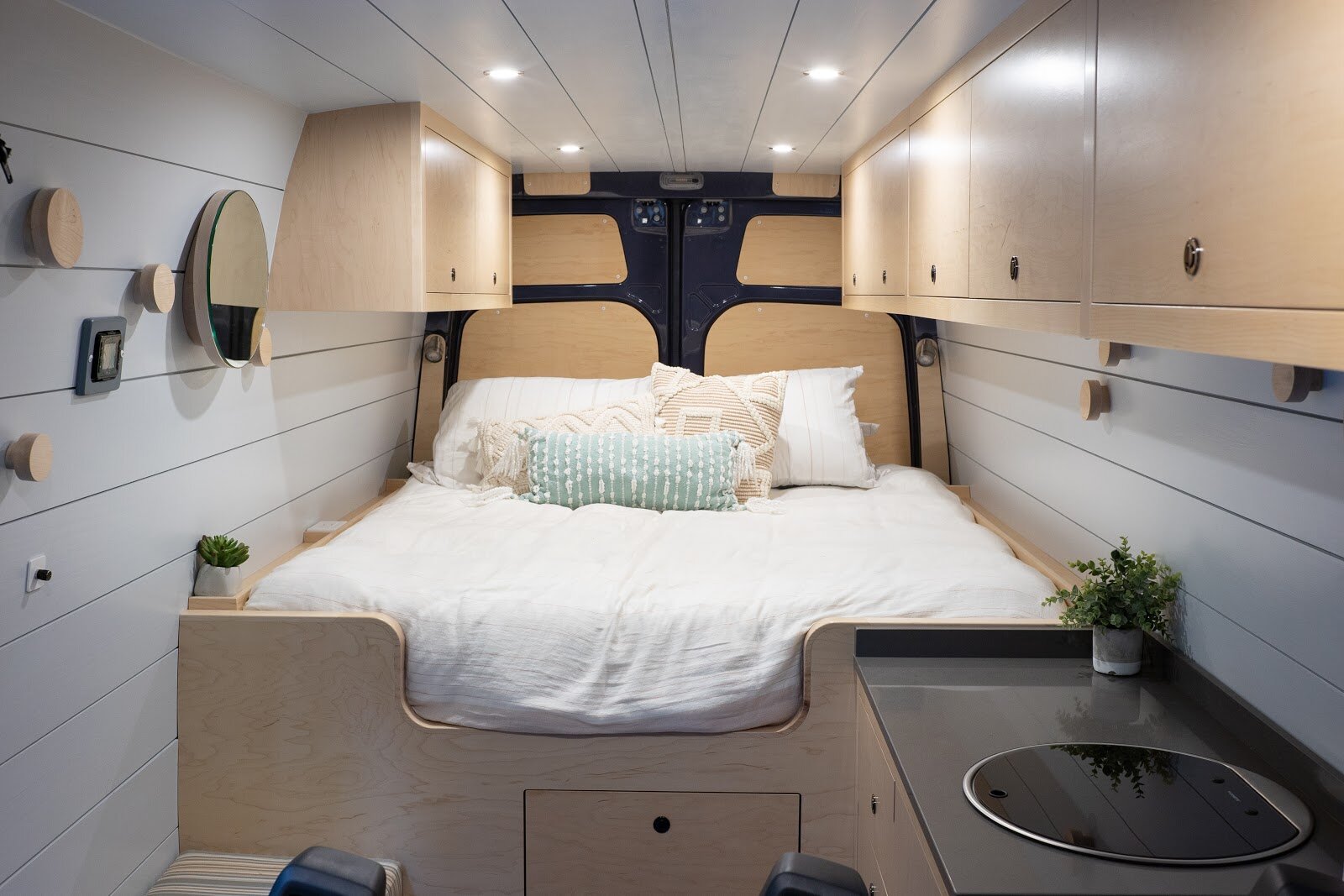
How to Afford a Sprinter Van Conversion
The world of camper vans has something for everyone, with older used options ranging from just a couple thousand dollars, to brand new 4×4 Sprinter conversions that clock in well over $200,000. Investing in a high-end, new Mercedes Sprinter van build with a custom conversion is a big financial step for most people.
So how is this trend growing at such a fast rate? How are people affording Sprinter cargo vans and builds from van conversion companies, with total costs upwards of $200,000? The fact is, there are several ways to fit a high-end Sprinter van conversion cost into your budget. Ready for all the tips on how to afford a Sprinter camper van? Keep reading!
Photo credit: Muse & Co. Outdoors
Get Financing (Not Available for DIY Van Conversions)
If you don’t have six figures of cash to buy a converted Sprinter van upfront, you’re certainly not alone. Many people choose to finance their camper van conversions.
If you’re purchasing a new Sprinter van from a Mercedes dealership, and you’re working with an approved builder, like Muse & Co. Outdoors, they’re often able to roll the price of the van conversion together with the price of the van chassis, and finance up to 75% of the total cost (van + conversion).
RV loans are offered by a variety of lenders, including some credit unions. Interest rates vary widely based on the terms of the loan, but APRs below 5% are not unheard of. Depending on the lender, an RV loan may cover all or part of the van itself, the conversion, or both. You may also be able to get a vehicle loan for the van itself, and a separate RV loan for the conversion.
If you have good credit and a steady income, a financing loan is a fantastic way to get the van you want right now. For example, Muse & Co. Outdoors offers financing through Hearth. Hearth makes it easy for you to find monthly payment options for your van conversion, with:
-
Loan amounts up to $100,000
-
Terms from 2 – 12 years
-
Direct funding in days from application
-
No penalty for early payment
-
Home equity not required to qualify
An important note: Those looking to do a DIY van conversion to avoid the extra costs associated with buying a converted van will not be able to get a traditional RV loan. Costs for DIY camper vans are many, and include components like electrical systems with solar panels and inverters, propane systems, water tanks and water heaters, vent fans, and various components like countertops, flooring, etc. Financing companies don’t want to sort through the value of these items, and they don’t trust DIY builders to turn these components into something worth as much or more than the individual parts.
Photo credit: Muse & Co. Outdoors
Take an Extended Road Trip
Of course, there are more creative ways to make buying a camper conversion a financial reality. You are, after all, investing in a tiny home on wheels – so one path that many vanlifers take is to move into their vans for a period of time to the cost of the van by avoiding rent and mortgage payments. While this is not an option for some individuals and families, others may have the flexibility to make a nomadic lifestyle work, even if just for a period of time. High roof vans like Mercedes and Dodge Sprinters, Ford Transits, and Ram Promasters have enough room for many people to live comfortably full-time.
For those who can make it work, living out of a camper van comes with many major benefits. First and foremost, of course, is the fact that you get to spend your time in the places you love the most. And, as thousands of people who have moved into their camper vans across the U.S. are learning, there are many valuable life lessons to be learned by simplifying and living a minimalist lifestyle.
This option will especially appeal to those who are able to work remotely. With off-grid electric systems powered by deep-cycle lithium batteries, vans now serve as functional mobile offices for many people. You can pull out your laptop and clock in wherever you have cell service. Plus, for people working remotely and living in their vans full-time, it’s possible to save a huge amount of money on taxes by legally writing off the van and conversion as a business expense.
Living rent and mortgage-free, even if just for a few months, can go a long ways towards paying for your own van—especially if you are able to work remotely. This option isn’t for everyone, but for those with the freedom and flexibility to hit the road for a few months, the potential for amazing adventures and major savings is hard to pass up.
Let Your Camper Van Work for You
Many van owners across the U.S. are taking advantage of the fact that Sprinter camper vans are in high demand, and they depreciate very slowly. Many people buy converted Sprinter vans, use them for one or two long road trips, and then sell them for the same amount or slightly less than they paid for them.
But there’s another option, for people who aren’t interested in selling their van, and still want to capitalize on their new asset. Now, van owners can rent their vans to others who are looking to get a taste of the #vanlife! Outdoorsy is a fast-growing platform that allows owners of Sprinter camper vans to advertise and rent their rigs to others. GoCamp is another great option if you own a top notch van – they’re a boutique rental company that only offers the cream of the crop to their picky clientele.
And the best part? Rentals aren’t cheap – with professionally converted Sprinters routinely going for upwards of $300 per night! With minimal effort, you can pay for a significant portion of your camper van by renting it just a handful of times per year. Outdoorsy and GoCamp take a small percentage of each rental transaction in exchange for listing on their platforms, but they also help you out by offering insurance and screening drivers before allowing them to rent your van.
You can set your calendar to make your van available as often or as infrequently as you’d like. If you take your van on trips 2 weekends out of every month, you could easily make $1200 or more per month, just by renting it out the other two weekends! It’s no wonder why Outdoorsy and GoCamp are fast-growing platforms—this is both a great way for van owners to make money and pay for their conversion, as well as an awesome opportunity for people looking to get away and taste the van life!
There’s no getting around it: A Sprinter camper van is a major investment, and you should definitely consider whether this is a dream that’s worth chasing for you and your family. Fortunately, these tips can make it easier to fit a conversion van into your budget. If a new Sprinter is in the cards for you, make sure you protect your investment by purchasing an insurance policy that covers both the van and the buildout itself.
As Sprinter van conversion experts and vanlife lovers we understand how daunting it can be to figure out the best financing option to make your dream van a reality. If you’ve got any questions we’re here and happy to help.
~ Your friends at Muse & Co. Outdoors
DIY Sprinter Van Build vs. Professional Conversion Company: Pros and Cons
Photo by Muse & Co. Outdoors
Tackling a van conversion project yourself can be rewarding, but it is a truly massive undertaking and many people do not understand the implications of such a project. If you are trying to decide between a DIY van conversion and hiring a professional camper van builder, you should start by educating yourself on the pros and cons of each route. Keep reading this article to learn more about DIY vs. professional Sprinter van builds.
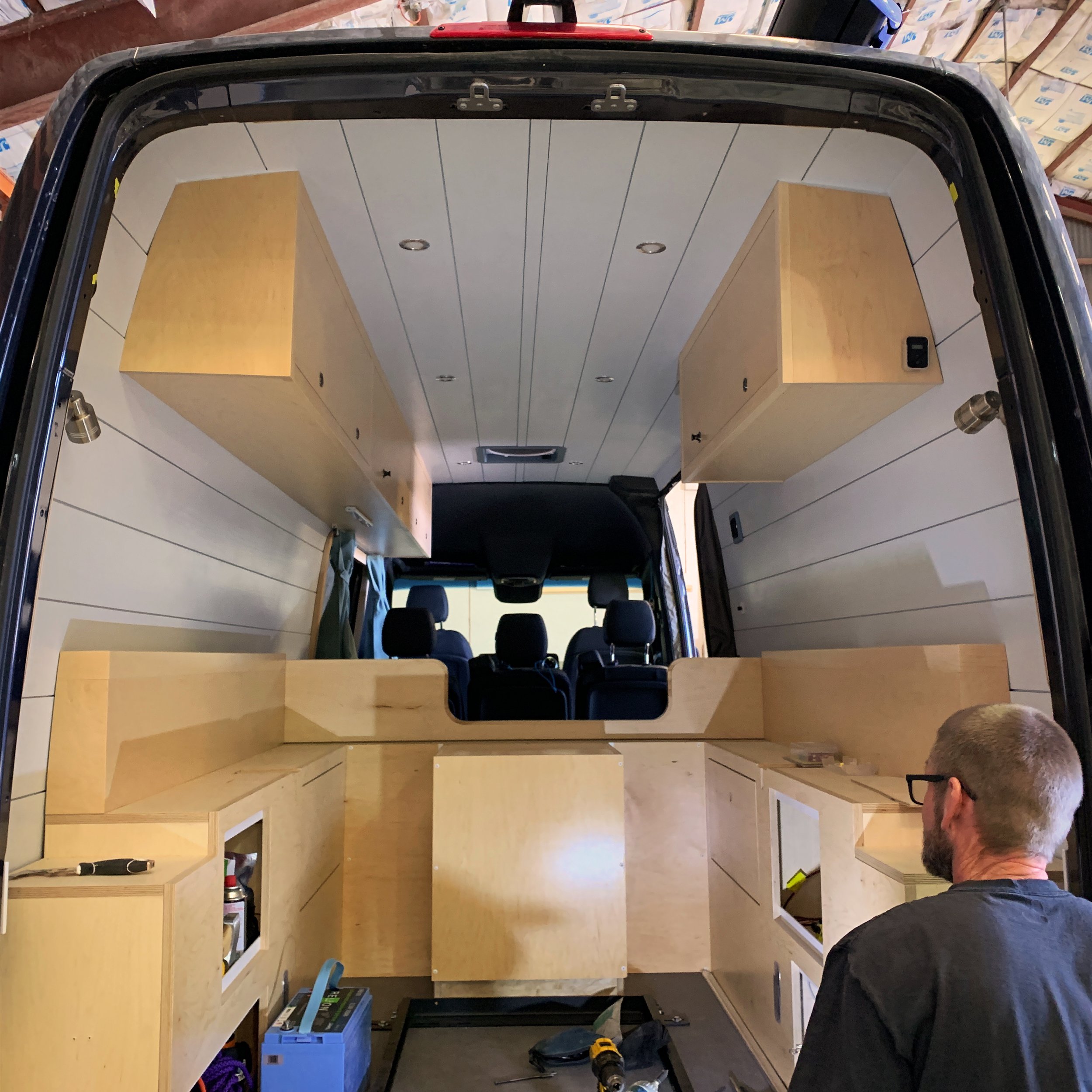
Photo by Muse & Co. Outdoors
The True Cost of a Sprinter Van Conversion
The main reason that most people decide to take on a van conversion themselves is cost. And with good reason: By cutting out labor costs, DIYers can save thousands of dollars by converting their own van. Of course, the old adage will tend to apply here: “you get what you pay for”. While you can save a lot of money doing a van conversion yourself, you need to be reasonable about how the end result will compare to a professional conversion.
Plus, while the DIY route will almost always be cheaper than hiring a conversion company, there are many costs associated with converting a van that most people overlook when starting their conversion, leading many DIY builds to end up over budget. A few of the “hidden” costs of converting a Sprinter van yourself include:
- Tools: A van build is an extremely involved project, requiring a variety of skills from plumbing, to electrical wiring, to carpentry and cabinetry. Each of these aspects of the build requires specialized tools. Simply put, converting a van properly requires A LOT of tools. Be sure to factor the cost of tools into your overall budget.
- Hardware, fittings, wiring, and other hidden building material costs: When most DIYers create a budget for their van build, they include the cost of major appliances like a fridge, heater, lights, etc. Many even factor in the cost of wood required to build the cabinets and walls. But a huge cost that many people overlook is that of the varied hardware, plumbing and electrical fittings, electrical wires, and other random fasteners and doo-dads that are inevitably required in a van build. While none of these items costs very much individually, they can quickly add up and eat into your overall budget.
- Mistakes: Some people that build their own van conversions are lucky to already have expert carpentry skills. Others might be familiar with propane systems or 12-volt electrical wiring. But even if you are lucky to have some relevant experience, you are almost certain to encounter parts of your van conversion that are totally new to you. Most DIY van builders make several mistakes during the process, and depending on the situation, these can be costly and require repurchasing of parts and/or lengthy setbacks.
Sprinter Van Resale Value: DIY vs. Professional Conversions
Some van owners buy a van and keep it for decades. But unexpected things happen, even to those who plan on owning their Sprinter van for a long time. Like a car or house, a Sprinter camper van should be treated as an investment, and resale value should be considered when planning your build.
Unsurprisingly, professional van conversions tend to hold their value much better than DIY builds. Even a DIY build of comparable quality to a professional one (a rarity) is likely to sell for less than its pro-built counterpart, simply because buyers can’t reference the builder and check their reputation.
Camper van resale value is an important consideration for any prospective Sprinter van owner. It is not uncommon in today’s market for a professionally-built van to resell with tens of thousands of miles on it for as much or more than the cost of the brand-new van and conversion. Why? Because most camper van builders have long waitlists and some buyers are willing to pay a premium for a used camper van that they can have immediately.
Insurance
Insuring a converted camper van can be simple, but it is also sometimes extremely difficult. Since Sprinter vans start out as cargo vehicles and are converted into campers, they sometimes don’t meet an insurer’s definition of an “RV”. Insuring your van as a passenger vehicle won’t work, because the value of the conversion itself will not be covered.
Fortunately, most major insurance companies now recognize converted camper vans as a legitimate RV, as long as they are converted by an accredited builder. This is bad news for DIY builders looking to insure their camper van, as they will have many more hoops to jump through to get their van and conversion properly insured. Insurance is yet another reason why hiring a professional van conversion company is a safer and easier choice.
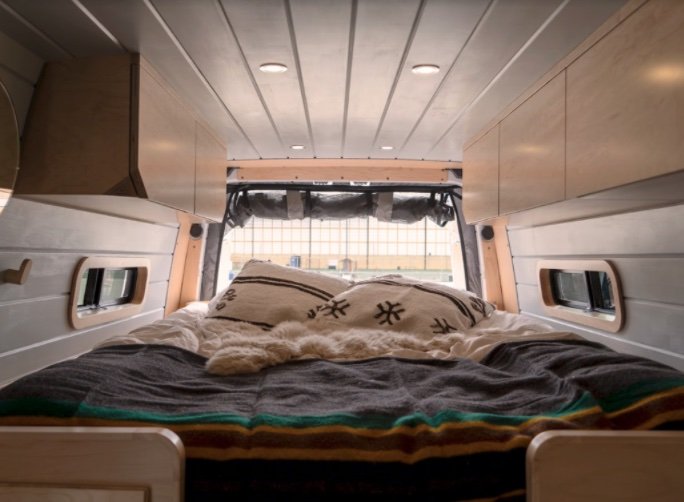
Photo by Muse & Co. Outdoors
Build Quality
When it comes to the quality of a Sprinter van conversion, there are a lot of factors. Build materials used, craftsmanship, components included, and durability of the build should all be considered. It would certainly be unfair to say that all professional camper van builds have higher build quality than all DIY builds; there are some truly craftsman-quality home-built camper vans out there, just as there are some conversion companies looking to make a quick buck by cutting corners in their build process.
Chances are, if you’re reading this article, you are not one of the few at-home craftsmen who have the time, tools, expertise, and resources to produce a truly professional-quality van conversion. A truly quality camper van conversion is hallmarked by a beautiful interior, intuitive functionality, and the ability to hold up to harsh road conditions for years to come. In an environment like a camper van, converting a van with true quality requires a master level of craftsmanship. Not only are none of the interior surfaces of a van square or level, but the van is a moving environment and the build-out needs to be able to handle the elements as well as the bumps of the road.
If you choose to go with a professional van conversion company for your Sprinter build-out, make sure to choose a builder that meets the highest standards for craftsmanship and overall quality. If you are looking for the top Bay Area Sprinter camper van builder, look no further than Muse & Co. Outdoors! Muse & Co. Outdoors creates some of the most beautiful, state-of-the-art Sprinter van conversions on the market today. Our builds feature cutting-edge sustainable materials and components, elegant and functional layouts, and plenty of versatility to fit your lifestyle. Check out our “build my van” tool to start exploring your options today!

